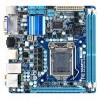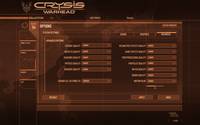- Qualcomm Launches Snapdragon 4 Gen 2 Mobile Platform
- AMD Launches Ryzen PRO 7000 Series Mobile & Desktop Platform
- Intel Launches Sleek Single-Slot Arc Pro A60 Workstation Graphics Card
- NVIDIA Announces Latest Ada Lovelace Additions: GeForce RTX 4060 Ti & RTX 4060
- Maxon Redshift With AMD Radeon GPU Rendering Support Now Available
Gigabyte H55N-USB3 – Big Features, Small Package

Some might say that “bigger is better”, but when it comes to today’s PCs, that doesn’t have to be the case. Rather, you can easily build a feature-rich and high-performance PC that can be entirely hidden from view. Mini-ITX motherboards exist to help with that, and where those are concerned, Gigabyte’s H55N-USB3 is well-worth looking out for.
Page 3 – Test System & Methodology
At Techgage, we strive to make sure our results are as accurate as possible. Our testing is rigorous and time-consuming, but we feel the effort is worth it. In an attempt to leave no question unanswered, this page contains not only our testbed specifications, but also a fully-detailed look at how we conduct our testing.
If there is a bit of information that we’ve omitted, or you wish to offer thoughts or suggest changes, please feel free to shoot us an e-mail or post in our forums.
Test System
The table below lists the hardware for our current motherboard-testing machine, which remains unchanged throughout all testing, with the exception of the motherboard. Each motherboard used for the sake of comparison is also listed here, along with the BIOS version used. In addition, each one of the URLs in this table can be clicked to view the respective review of that product, or if a review doesn’t exist, you will be led to the product on the manufacturer’s website.
|
Component
|
Intel LGA1156 Test System
|
| Processors | Intel Core i5-661 – Dual-Core, 3.33GHz, Stock Voltage |
| Motherboard |
ASUS P7H55D-M EVO – H55-based, 0503 BIOS (12/08/09)
Gigabyte H55M-USB3 – H55-based, F6 BIOS (02/12/10) Gigabyte H55N-USB3 – H55-based, F5b BIOS (07/14/10) Intel DH55TC – H55-based, 0026 BIOS (11/13/09) |
| Memory |
Corsair XMS3 DHX 2x2GB – DDR3-1333 7-7-7-20-2T, 1.65v
|
| Graphics |
ASUS Radeon HD 5850 1GB (Catalyst 9.12)
Intel HD Graphics (for non-gaming tests) |
| Audio |
On-Board Audio
|
| Storage | |
| Power Supply | |
| Chassis | |
| Display | |
| Cooling |
Thermalright MUX-120
|
| Et cetera |
When preparing our testbeds for any type of performance testing, we follow these guidelines:
-
General Guidelines
- No power-saving options are enabled in the motherboard’s BIOS.
- Internet is disabled.
- No Virus Scanner or Firewall is installed.
- The OS is kept clean; no scrap files are left in between runs.
- Hard drives affected (not SSDs) are defragged with PerfectDisk 10 prior to a fresh benchmarking run.
- Machine has proper airflow and the room temperature is 80°F (27°C) or less.
-
Windows 7 Optimizations
- User Account Control (UAC) and Action Center messages are disabled.
- Windows Defender, Firewall, Security Center, Search, and Updates are disabled.
Because it gives a more realistic interpretation of motherboard/CPU performance, we leave all of the power-related options in the BIOS to their default selection. This means that for Intel boards, SpeedStep is left in tact, and Cool’n’Quiet for AMD-based boards.
 Our Windows 7 Desktop for Motherboard-Testing |
To aide with the goal of keeping accurate and repeatable results, we alter certain services in Windows 7 from starting up at boot. This is due to the fact that these services have the tendency to start up in the background without notice, potentially causing slightly inaccurate results. Disabling “Windows Search” turns off the OS’ indexing which can at times utilize the hard drive and memory more than we’d like.
Application Benchmarks
To help test out the real performance benefits of a given processor, we run a large collection of both real-world and synthetic benchmarks, including 3ds Max 2010, Adobe Lightroom 2.5, ATTO, PCMark Vantage, Sandra 2010, 7-Zip and more.
Our ultimate goal is always to find out which processor excels in a given scenario and why. Running all of the applications in our carefully-chosen suite can help better give us answers to those questions. Aside from application data, we also run two common games to see how performance scales there, including Call of Duty: Modern Warfare 2 and Crysis Warhead. For a synthetic point-of-view, we also use Futuremark’s 3DMark Vantage.
Game Benchmarks
In an attempt to offer “real-world” results, we do not utilize timedemos in any of our reviews. Each game in our test suite is benchmarked manually, with the minimum and average frames-per-second (FPS) captured with the help of FRAPS 3.0.1.
To deliver the best overall results, each title we use is exhaustively explored in order to find the best possible level in terms of intensiveness and replayability. Once a level is chosen, we play through repeatedly to find the best possible route and then in our official benchmarking, we stick to that route as close as possible. Since we are not robots and the game can throw in minor twists with each run, no run can be identical to the pixel.
Each game and setting combination is tested twice, and if there is a discrepancy between the initial results, the testing is repeated until we see results we are confident with.
The two games we currently use for our motherboard reviews are listed below, with direct screenshots of the game’s setting screens.
Call of Duty: Modern Warfare 2
Crysis Warhead
Although the screenshots reflect a 1680×1050 resolution, we also test using 2560×1600.
Support our efforts! With ad revenue at an all-time low for written websites, we're relying more than ever on reader support to help us continue putting so much effort into this type of content. You can support us by becoming a Patron, or by using our Amazon shopping affiliate links listed through our articles. Thanks for your support!








